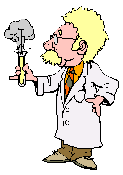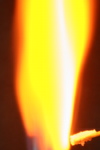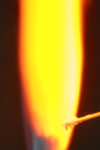
|

|
Jump back to one of the following links:
|
|
|
|

|
|
|
Jump to one of the following atomic and electronic structure parts:
|
| |
|
|
|
|
Tutorial: Atomic and Electronic Structure
Part 1- Atomic Spectra
|
|
When heated, some elements emit visible light. I can take compounds made
from these elements, put them in the flame of a burner, and then examine the flame
color. One way to do this is to use wooden splints dipped in each compound. The
splints need to be soaked for hours in distilled water. Since the wood becomes saturated
with water, the splint does not readily burn and so does not contribute to the flame color (taken from Flinn publication #?). This procedure is also nice because the
compound generally sticks quite well to the wet splint.
However, if I put sodium chloride into a flame, how do I know what the resultant
color is due to? Sodium ion or chloride ion? I'm going to state that it's due to the
sodium ion but you shouldn't necessarily believe me without some data, right? Here
are four sodium compounds so you can judge for yourself-

|

|

|

|
|
sodium chloride
|
sodium iodide
|
sodium bromide
|
sodium nitrate
|
|
NaCl
|
NaI
|
NaBr
|
NaNO3
|
If the anion had anything to do with the flame color then I might expect to see some
kind of major variation among the three halides and the nitrate compound. Since
there is no major color variation, it's reasonable to point your finger at sodium ion.
The heat from the flame excites electrons in sodium ionss. These excited electrons
eventually drop back to their ground state and emit light whose wavelength falls in the
visible yellow area of the electromagnetic spectrum.
How about some more colors?

|

|

|

|

|
|
red
|
scarlet
|
orangish
|
emerald green
|
violet
|
|
lithium carbonate
|
strontium nitrate
|
calcium chloride
|
copper(II) sulfate
|
potassium chloride
|
|
Li2CO3
|
Sr(NO3)2
|
CaCl2
|
CuSO4
|
KCl
|


 updated 10:26 AM, 7/22/02
updated 10:26 AM, 7/22/02
chemistry@chemistry.alanearhart.org
© Copyright Notice









![]()
![]()
![]() updated 10:26 AM, 7/22/02
updated 10:26 AM, 7/22/02